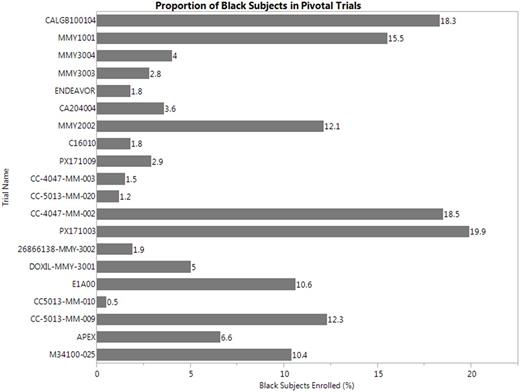Abstract
Introduction
Multiple Myeloma (MM) is a clonal plasma cell neoplasm characterized by end organ damage or derangement of highly specific biomarkers. The incidence of MM in the United States (U.S.) is estimated to be 30,280 new cases per year, accounting for approximately 1 percent of all cancers and 12,590 deaths per year.(1) The median age of diagnosis of MM has been reported as 66 years in the literature.(2) The incidence of MM is two to three times higher in black individuals than in whites, but the biological etiology of the observed higher incidence is undetermined. Blacks constitute 20% of the population affected by MM despite accounting for 13% of the U.S. population.(3,4) This disparity is also observed in the precursor condition, monoclonal gammopathy of undetermined significance (MGUS). Here we analyze the racial makeup of the pivotal trials submitted to the U.S. Food and Drug Administration (FDA) in support of MM indications with comparisons to the U.S. MM population.
Methods
We reviewed internal databases for NDA and BLA submissions to the FDA's Division of Hematology Products between 2003 and 2017. The pivotal trials supporting each application were reviewed for baseline demographic data, including age, race, and country. The clinical reviews, prescribing information, and clinical study reports were also reviewed. Intention-to-treat populations were examined. Analysis was conducted only on pivotal trials that included race data.
Results
We found 21 original or supplemental NDAs or BLAs submitted between 2003 and 2017 in support of MM indications. The applications included 23 pivotal trials that were relied upon to support approval. Of these, 20 included race data. The median ages in each pivotal study ranged from 58 to 73 years, with a median age across trials of 64 years. The range of enrollment of black subjects in the pivotal trials was 0.5% to 19.9% of the trial population. The median percentage of blacks enrolled across the trials was 4.5%. The figure below shows the proportion of black subjects enrolled by trial. The enrollment of U.S. subjects in pivotal trials varied widely, with a median of 9.3% across trials. No chronologic trend was evident in U.S. enrollment, but U.S. participation was higher for new molecular entity (NME) pivotal trials as compared with supplemental applications. We found an association between U.S. enrollment and racial representation in clinical trials. In trials that had low U.S. enrollment, the median proportion of blacks enrolled was 1.8%, whereas in trials that had high U.S. enrollment, the median was 10.5%.
Discussion
In trials submitted in support of MM indications, the median percentage of blacks enrolled was 4.5%. SEER data from 2014 suggest that blacks represent 20% of the MM population. Based on these findings, enrollment of black subjects in pivotal trials submitted for U.S. regulatory approval is not representative of the population affected by MM. Even in trials that had high U.S. enrollment, black subject enrollment was not representative of the population affected by this disease. Underrepresentation of black patients in pivotal trials could be due to a number of factors, including access to care, and referral patterns to study enrollment sites.
Meaningful differences may exist in MM disease biology, presentation, and response to treatment in blacks compared to whites.(5) Higher enrollment of black subjects in clinical trials would have multiple benefits. First, underserved populations would have improved access to novel therapies. Second, pivotal trials would be more representative of the U.S. population, which is a consideration within the regulatory benefit-risk framework. Finally, the additional data would provide further understanding of the MM disease biology in black patients, and potentially identify molecular subtypes that could be targeted by established or novel drugs.
References:
1. Siegel, R, et al., Cancer statistics, 2017. CA: A Cancer Journal for Clinicians. 2017; 67: 7-30
2. Kyle, R., et al., Review of 1027 patients with newly diagnosed multiple myeloma. Mayo Clin Proc. 2003; 78(1): 21
3. SEER database 2014 Estimated United States Cancer Prevalence Counts on January 1, 2014. By Race/Ethnicity, Table 18.21.
4. Rastogi, S., et al., The Black Population: 2010. US Census Department.
5. Waxman, A., et al., Racial disparities in incidence and outcome in multiple myeloma: a population-based study. 2010; 116 (25): 5501-6
No relevant conflicts of interest to declare.
Author notes
Asterisk with author names denotes non-ASH members.


This feature is available to Subscribers Only
Sign In or Create an Account Close Modal